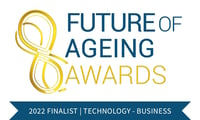The aged care industry is regularly cited as one of the most stressful industries to work in, with research finding that aged care workers tend to work longer hours, get paid less and report more cases of work-related stress, depression and anxiety.
Considering the nature of the job itself, which involves caring for some of the most vulnerable people in society and therefore having to deal with emotional issues such as the deterioration of a resident’s health, it’s little surprise that stress is commonly experienced amongst care staff - and there’s no doubt that this will have been exacerbated further by the pandemic. On top of the usual concerns, carers are now facing fear of personal infection and fear of passing infection on to friends and family members, with the potential toll of isolation, restricted movement and reduced social functioning further contributing to the problem.
In an aged care setting, high levels and prolonged periods of stress can compromise a professional’s ability to provide high quality care to his/her residents. Therefore, it’s important that excess stress within the care environment is spotted and treated early, and that procedures are put into place to mitigate any feelings of unnecessary stress on the care workforce.
One solution that aged care businesses can pursue, in order to help their employees to be healthier, happier and stress free, is the use of technology within the care environment.
There is now widely adopted technology available that allows carers to digitally plan, record and monitor the care of their residents whilst on-the-go. Accessed through a handheld device, care can be evidenced with a simple tap of the finger, in real time. There’s no more rushing off the floor to write up care notes or having to factor time into the working day for updating documentation. Instead, carers can focus on spending as much time as possible with their residents, and on ensuring that their care needs are being met. What’s more, shift handovers are simplified by having up-to-date, searchable information available for staff, plus instant access for everyone in the circle of care.
As well as providing care staff with the capabilities to reduce workloads and save time, technology too can help with minimising the risk of errors being made during care delivery. An industry where such errors can have fatal consequences, caring can have significant costs and the burden of this on carers can often feel overwhelming. Without sufficient support, this can take its toll on carers' emotional and physical health and have a knock-on effect on their ability to work. Any technology that can assist in this area is therefore incredibly valuable to care providers and shouldn’t be overlooked.
With functions that instantly alert staff to any missed care, for example any incidents or deficiency of fluids, a high quality of care is easier to maintain – creating visibility for all involved in care. By equipping carers with the tools that they need to do their jobs more efficiently and to a higher standard, they feel more empowered and better able to support their residents. This in turn reduces any feelings of ‘carers’ burden’ and boosts staff morale.
What’s more, shift handovers are simplified by having up-to-date, searchable information available for carers, plus instant access for everyone in a resident’s care circle, as well as family members. With solutions available that keep relatives directly updated on the care and wellbeing of their loved ones, the stress of keeping family members informed and fielding calls from worried relatives is drastically reduced.
Overall, it’s clear that technology can be of great benefit to all aged care providers. By automating daily tasks and enabling care to be evidenced at the point of delivery, it can alleviate much of the stress experienced by caregivers, driving efficiencies in service and in turn improving the lives of residents. The benefits of mobile technology are obvious. However, not all of Australia’s aged care facilities are taking complete advantage of the technology on offer currently. There is still some way to go to achieve mass implementation, so that these benefits can be felt by more of Australia’s ever-increasing aged care workforce.











